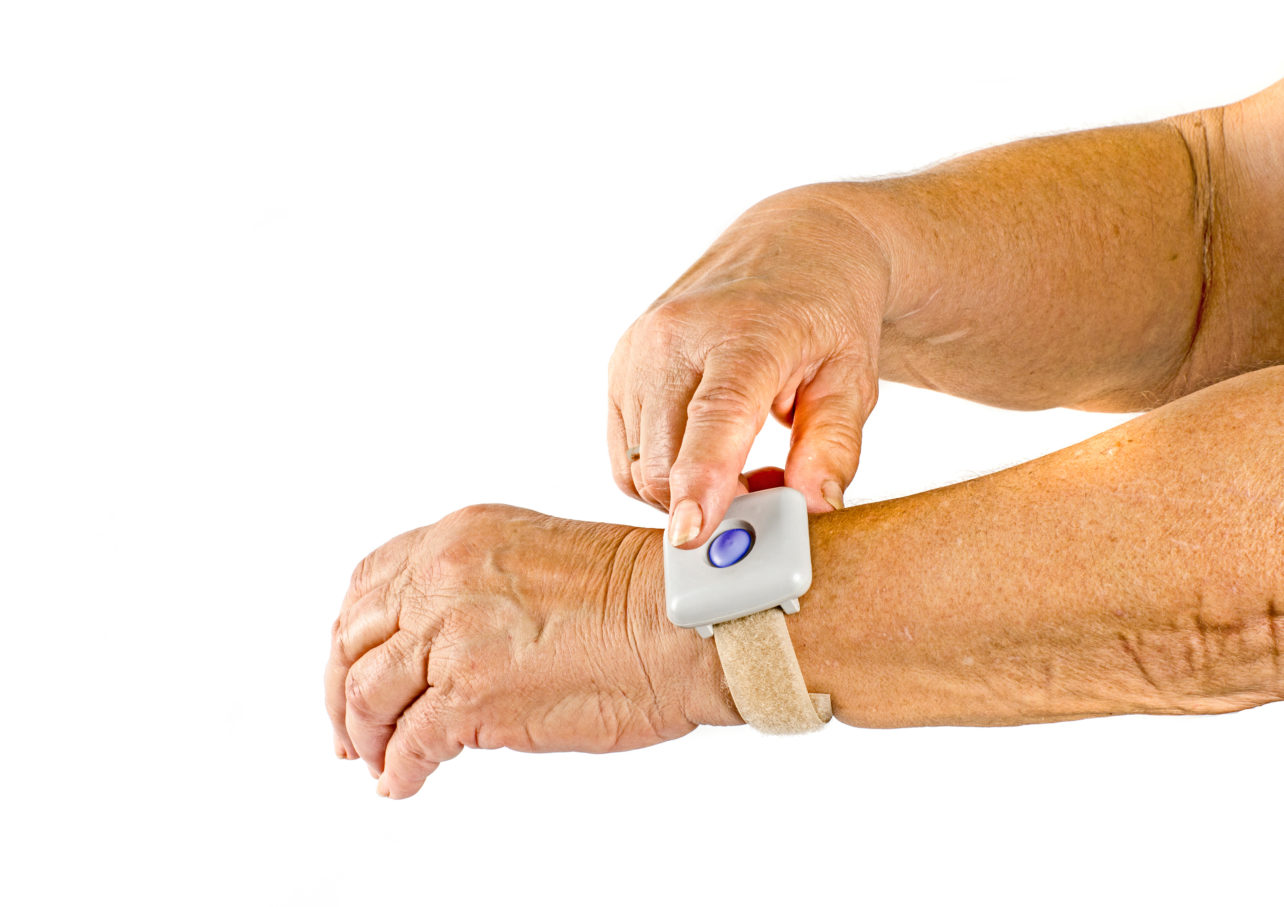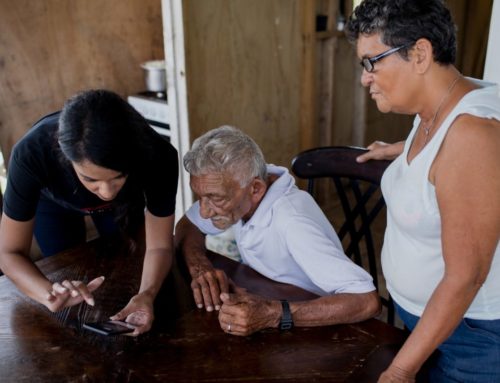Many older adults prefer to age in place. They wish to enjoy familiar surroundings close to friends and family and places they enjoy visiting. While they may not require in-home care, aging adults and their loved ones could find some peace of mind when using a medical alert system like that offered by Medical Guardian.
What is Medical Guardian?
The medical alert company, Medical Guardian, was founded by Geoff Gross. After his own grandmother experienced several falls, Gross identified the need for a medical alert system for older adults who wish to maintain their independence. So he decided to develop technology to prevent falls, and Medical Guardian was born.
Medical alert systems are also sometimes called medical alarms or personal emergency response systems. These devices contact a monitoring center in the case of an emergency. The monitoring center can then assist the individual by providing support, connecting them with their Care Circle, or sending emergency medical personnel to their home. Medical Guardian’s monitoring centers are available 24 hours a day and seven days a week.
Medical Guardian is 100% U.S.-based. That means the company does not outsource its monitoring center. This eliminates potential language barriers that one may encounter when speaking to an operator in another country. Customers who speak a language other than Spanish or English can be accommodated. In these cases, Medical Guardian uses a translation service to provide foreign language customers with the best and quickest possible assistance.
Medical Guardian has monitoring services in all 50 states. That means On-The-Go devices can be worn while you travel. Home-based units can also be taken along. In this case, you need to let the monitoring center know so that they can update your location. You can then connect the device to the landline or 4G LTE or WiFi where you will be staying.
Medical Guardian’s alert system keeps your information on file. This includes your medical history, current medical condition, and medications that you are taking. This information can quickly be relayed to any emergency teams that are sent to assist you. Medical Guardian also contains the contact information of individuals who you want to include in your Care Circle. This could include anyone from your medical team to family, friends, and neighbors.
Medical Guardian offers a lifetime warranty on its products. If your medical alert system malfunctions or arrives damaged, the company will replace it free of charge. However, the warranty does not cover products that are damaged or stolen while in your possession. You could purchase a protection plan from Medical Guardian that covers these situations.
What type of services does Medical Guardian provide?
All Medical Guardian’s portable devices, including the Help Buttons (or emergency buttons) linked to home systems, are waterproof. That means you can wear them while taking a shower or when you are in the bath or around the pool – areas where there is a higher risk of slipping and falling.
Medical Guardian’s monitoring center is equipped with state-of-the-art technology and a triple-redundant backup system. This means you will be able to connect with them during power outages and snowstorms as long as you have a cellular connection, WiFi, or your landline (depending on how your device is connected).
On-The-Go Systems.
Active Guardian.
The Active Guardian mobile medical alert system incorporates both GPS tracking and WiFi location technologies. The device can be worn around the neck by attaching it to a lanyard. When the emergency call button is pressed, the device uses a cellular network to connect the user to the Medical Guardian monitoring center. In addition, the Active Guardian device can be used to communicate with an operator via the built-in speaker. The operator can use the device’s GPS tracking and WiFi features to pinpoint your location and dispatch emergency services.
Mini Guardian.
The Mini Guardian is small, compact, and lightweight – weighing only 1.3 ounces. The device comes in three colors: silver, black, or white and can be worn on a lanyard or belt clip. The Mini Guardian’s battery takes 3 hours to charge fully and can last up to 5 days.
Mobile 2.0.
The Mobile 2.0 device connects anywhere where cellular service is available. It offers advanced location monitoring features through 4G LTE, WiFi, and GPS. The emergency medical alert system can be clipped to your clothing or placed in your bag. The Help Button can be removed and placed in one of two wearables – a wristband or a necklace.
Home Systems.
Classic Guardian.
The Classic Guardian’s base station connects to a landline telephone. The medical alert Help Button can be worn on a lanyard or the wristband that is included. The base unit can pick up an emergency signal if the Help Button is pressed. The base station then contacts the Medical Guardian monitoring center.
This feature will only work when the Help Button is within 1,300 feet of the base station. This distance could vary depending on the environment, the condition of the equipment, and the location of the portable device. On the Medical Guardian Classic, only the base unit has a 2-way speaker. This means you will need to be within relatively close proximity of the base station if you want to communicate with the operator.
The benefit of the Classic Guardian system is that multiple Help Buttons can connect to one base unit. This makes it ideal for couples or housemates. Other add-on accessories include a fall alert pendant (for automatic fall detection), wall-mounted button, voice-activated wall button, and lockbox. The wall-mounted button can provide up to 2,000 feet of coverage in the home. It can wirelessly connect an individual to the Medical Guardian monitoring center.
The voice-activated wall button can connect you with the monitoring center when you pull the attached cord. It can also be activated by saying ‘Call Medical Guardian’ twice.
Medical Guardian’s Lockbox safely stores your key in a weatherproof lockbox. This allows emergency responders and your emergency contacts to quickly access your home in the event of an emergency.
Home 2.0.
Home 2.0 has a range of 1,400 feet and uses 4G LTE and WiFi to connect you to the Medical Guardian monitoring center. The Help Button can be worn as a necklace or on a wristband. Both of these wearables are included and can be ordered in either black or white. However, only the base station is equipped with a 2-way speaker. In the event that you are unable to speak to the operators in the monitoring center, emergency services will be dispatched to your home.
Home 2.0 can also be connected to more than one Help Button and can be combined with wall buttons and fall detection or fall alert buttons.
The MyGuardian App by Medical Guardian.
MyGuardian is a mobile app and desktop portal that streamlines contact and communication with and between caregivers and emergency contacts. The app allows you to manage the contacts in your Care Circle from your mobile device. These are your loved ones and persons who you wish to be contacted in the event of an emergency. The chat feature lets you easily connect and speak to those individuals.
The platform also makes it easy to manage your billing. It allows you to view your invoices and transaction history and update your payment details. Through the app, you can make one-time payments or enable autopayments.
Some metrics of the Mobile 2.0 and Mini Guardian devices can be tracked via the MyGuardian app. The platform can show the current location of your medical alert device as well as its location history, provide system status reports, and display the battery and connectivity history.
The MyGuardian portal also allows you to track the shipment of new products and download product manuals and eBooks.
The MyGuardian app can be downloaded to Apple devices via the app store or Google Play for Android. The app is currently only available for Medical Guardian systems purchased after 1 August 2021.
How much does Medical Guardian cost?
Home-based Medical Guardian devices and services can cost less than $1 per day. On-the-go products and services start at $1.20 per day. Some systems may have a once-off hardware fee that you will need to pay when you sign up. Payment can be made monthly, quarterly, or annually. Annual plans generally work out less expensive than quarterly or monthly plans.
Medical alert systems are not covered by the basic Medicare plan since they are not strictly considered to be medical devices. This basic cover, called Medicare Part A, covers hospital care, hospice, lab tests, surgery, home health care, and nursing facilities. While Medicaid covers telehealth services, it does not necessarily cover the devices needed to access these services, like a tablet or another emergency medical alert device.
At an additional cost of $148 per month (usually taken from your Social Security benefits), you can be covered by Medicare Part B. Part B covers services like diagnosing and treating medical conditions. It also covers necessary medical equipment like walk-aids, oxygen cylinders, or blood sugar test strips.
Some Medicare Advantage plans (also called Medicare Part C) can cover medical alert systems. Medicare Advantage plans can be purchased through select private health insurance companies. These companies need to be approved by Medicare to offer this product. Most Medicare Part C plans cover everything that is included under Medicare Plan A and Plan B. Medicare Advantage plans differ from state to state, and it is worth enquiring whether this is an option available in your area.
In some cases, older adults may be able to make use of a medical alert system if they are eligible for Medicaid insurance. Medicaid eligibility is based on an individual’s assets and income. Different Medicaid programs serve individuals from different populations. In some cases and some states, medical alert systems may be covered through Medicaid.
Some medical alert system companies offer free shipping or discounted rates when purchasing multiple products or paying service fees in advance. Medical Guardian does this by offering discounted rates for annual payments, for example. This could make your medical alert system more affordable.
Medical alert systems could be seen as a Health Savings Account expense. These expenses often fall under the ‘medical information plans’ section on the IRS’s list of allowable medical deductions. This is because many of these systems keep a digital version of their customers’ medical records. It is best to consult with your tax advisor whether you could include your medical alert system in your medical tax deductions.
What do other people say about Medical Guardian?
Medical Guardian has held first place in Best Company’s rankings of medical alert system companies. The company was awarded the Silver Stevie Award of Excellence in Customer Service in 2019. In fact, Best Company is so confident in Medical Guardian that they offer consumers $100 if they are not satisfied with their purchase (within 30 days of purchase).
Medical alert devices like the Medical Guardian product range can give older adults and their loved ones some peace of mind while they age in place. These devices incorporate emergency buttons with location tracking and a fall alert button (in some cases, even automatic fall detection). This emergency button can enable aging adults to maintain their independence while knowing help is only a button-press away if they need it.
References:
- Wearable Medical Alert with Voice Assistant | Shop Mobile 2.0 (medicalguardian.com)
- Mini Medical Alert Button with GPS | Medical Guardian
- Active Medical Alert System with GPS | Medical Guardian
- Medical Alert System Accessories and Add-ons | Medical Guardian
- Alert Device With Necklace & Watch Button | Medical Guardian
- Home 2.0 4G Medical Alert System | Medical Guardian
- Medical Alert Devices Fall Detection | Medical Guardian
- Comparison of Medical Guardian’s Alert Systems | Medical Guardian
- MyGuardian Customer Portal | A Medical Alert Device Company (medicalguardian.com)
- Can Home-Monitoring Technology Help Prevent Falls in Seniors? – InHomeCare
- Our Medical Alert Monitoring Services | Medical Guardian
- How It Works: Award-Winning Medical Emergency Alert System | Medical Guardian
- Stay Updated with Medical News and Product Releases (medicalguardian.com)
- Executive Leadership Team | Medical Guardian
- Our Medical Alert Monitoring Services | Medical Guardian
- Comparison of Medical Guardian’s Alert Systems | Medical Guardian
- Buying Advice for Medical Alert Systems | Medical Guardian
- What Sets Us Apart | Medical Guardian Alert Device Experience
- About Medical Guardian | A Medical Alert Device Company
- Mobile GPS Medical Alert Devices | Medical Guardian
- Real Customer Reviews | Best Company
- 2021 Medical Guardian Review: Read Before You Buy (bestcompany.com)
- Medical Alert Devices For Seniors | Medical Guardian
- Medical Alert Systems & Monitoring Devices | Medical Guardian
- Are Medical Alert Systems Covered By Medicare? – Forbes Health




